Acting Locally, Thinking Globally
New GW institute unites bright minds to advance HIV/AIDS
research.
By Abby Vogel
On Aug. 29, 1981, GW’s Gary Simon diagnosed the first
recognized HIV/AIDS patient in Washington, D.C. More than
a quarter century later, Simon and other GW faculty members
are leading the fight against this deadly virus by creating
an institute that focuses on research, clinical care, and
collaboration among those in the medical community.
The newly created GW HIV/AIDS Institute is a network of researchers
and medical professionals using their knowledge to prompt
studies and provide patient care in Washington, D.C., where
the disease now affects 4 percent of the city’s residents.
Nationally, nearly 1 million HIV/AIDS cases have been reported.
This renewed focus on the epidemic is part of the GW Medical
Center’s strategic plan, which pinpoints HIV/AIDS as
a priority in the university’s diverse and talented
medical community.
“What we found was this enormous powerhouse of science
and talent from basic to social science, from clinical expertise
to public health,” says Alan E. Greenberg, chair of
the Department of Epidemiology and Biostatics. Greenberg co-founded
the institute with Simon, director of the Division of Infectious
Diseases and vice chairman of the Department of Medicine.
“We are convinced that the institute as a group will
be stronger than each of us as individuals.”
Five institutions represent the pillars of the multidisciplinary
and synergistic institute—GW’s School of Public
Health and Health Services, GW’s School of Medicine
and Health Sciences, GW’s Columbian College of Arts
and Sciences, Children’s National Medical Center, and
the D.C. Veterans Affairs Medical Center. Affiliate memberships
have also been granted to faculty from Howard University,
Georgetown University, and the Washington Hospital Center.
Through the institute, faculty provide clinical care for
HIV/AIDS patients and their families, work with metropolitan
area health departments, collaborate with international and
national players in the policy arena, and conduct extensive
research. “With the institute, we now have a rapidly
responsive network with partnerships and relationships that
will lend themselves to new granting opportunities and affiliations
as well as value added for the University,” Greenberg
says. “We are acting locally yet thinking globally.”
Greenberg and Simon are quick to acknowledge Sylvia Silver,
professor of pathology and associate dean for health sciences,
as the impetus for forming the institute and a leading force
in articulating its vision. Silver is a well-funded and noted
researcher in HIV/AIDS and recently extended her work to South
Africa.
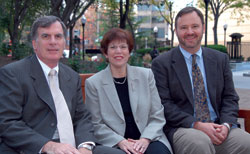
Professors Gary Simon, Sylvia Silver, and Alan E. Greenberg
are making an effort to expand the reach of education
and research projects addressing HIV/AIDS issues.
Jessica McConnell
|

|
As principal investigator in a collaborative effort to improve
the monitoring of the HIV/AIDS epidemic in Washington, D.C.,
Greenberg, along with epidemiology and biostatistics faculty
and staff members, is working with D.C.’s Department
of Health on epidemiological and surveillance issues, including
the District’s component of the Centers for Disease
Control and Prevention-funded National HIV Behavioral Surveillance
Project.
The institute has also developed a graduate certificate in
HIV/AIDS studies, which, pending final approval from the University,
will be offered through GW’s School of Public Health
and Health Services beginning in the fall of 2007.
“The GW HIV/AIDS Institute will have an important impact
city-wide,” says Lawrence D’Angelo, professor
of pediatrics and division chief for Adolescent and Young
Adult Medicine at Children’s National Medical Center.
“D.C. has declared HIV/AIDS a priority, and the institute
can provide the city with state-of-the-art research and collaboration.”
Fred Gordin, professor of medicine and chief of infectious
diseases at the D.C. Veterans Affairs Medical Center, stresses
that the recent creation of the GW HIV/AIDS Institute brings
together a network of experts and facilities not formally
linked in the past. “This is an opportunity for individuals
like me at the VA to be integrated more fully with all the
capabilities at GW,” he says.
A collaboration of this magnitude can positively impact
the HIV/AIDS research agenda. Gordin explains, “Advances
in the field have been remarkable in the last two decades.
The work that will be done because of the development of the
institute will not only help the field, but also help the
people right here in our own community.”
Clinical Studies

|
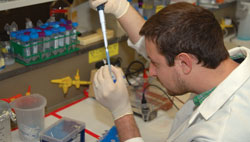
Postdoctoral student Luke Dannenberg conducts a ChIP-chip
experiment, which offers researchers the ability to
study the entire genetic information in a cell and determine
where a protein would bind on various chromosomes.
Jessica McConnell
|
“The test tube is the starting point, but until you
make that jump to patients, you never know how well it is
going to work,” says Simon, the institute’s co-chair.
At the GW Medical Faculty Associates, many HIV-infected individuals
seek antiretroviral agents and regimens. “We have established
a clinical practice in HIV/AIDS here that is well recognized
in the District and nationally,” he says.
More than 25 years after Simon diagnosed the first HIV/AIDS
patient, the fight against HIV/AIDS continues throughout the
District and the world. “The District of Columbia has
a major problem in both the diagnosis and treatment of HIV-infected
individuals,” Simon says. “The city is working
to improve this, but it is going to take a lot of work.”
A new approach was initiated by the MFA this year: a partnership
with Jeremy Brown, associate professor of emergency medicine,
to establish “Opt-Out Testing,” offering HIV tests
for all emergency room patients. “This is a new initiative
from the Centers for Disease Control and Prevention to make
sure that we identify and subsequently treat as many infected
individuals as possible,” Simon says. “We believe
that up to one-third of HIV-infected people don’t know
they are infected and thus may not be receiving therapy. Since
they are contagious, they may unknowingly be infecting others.”
Examining High-Risk Behaviors
Understanding the motivations behind risky behaviors that
lead to contraction of HIV/AIDS is the stock in trade of a
research team led by the psychology department’s Senior
Research Scientist Carol A. Reisen and Professors of Psychology
Maria Cecilia Zea and Paul Poppen, chair of the department,
in GW’s Columbian College of Arts and Sciences.
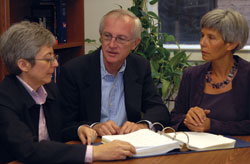
In order to send the most efficient HIV prevention message,
GW’s Maria Cecilia Zea, Paul Poppen, and Carol
A. Reisen are trying to understand the reasons behind
risky behaviors.
Jessica McConnell
|

|
“We’re interested in prevention,” Zea explains.
“We are trying to understand the ‘whys’—the
root causes and reasons why people behave in risky ways.”
Zea adds that the underlying goal of the team’s research
is determining how to send the most effective message about
HIV prevention to the Latino community.
“We’ve learned that it’s really complex,”
Zea says about why the incidence of the disease has not continued
to decline. “It’s not as straightforward as receiving
information and changing behavior. There are a number of variables
contributing to risk—poverty, discrimination, geography.”
Poppen says the team’s research has dispelled an important
myth about behavior—that risky behavior is based on
individual personality differences. He explains, “What
we’ve seen is almost anyone may engage in some form
of risky behavior depending upon the context of the particular
sexual event itself—if you’ve had alcohol or drugs,
who your partner is, what the setting is, and so on. What
we’re studying is how the context associated with specific
episodes may make it more likely for anyone to engage in risky
behavior.
“The bigger point,” he adds, “is that information
is not enough. That’s part of the problem with health
issues that are behaviorally related. Behavior is not that
easy to control. It’s a big challenge.”
Adolescents and Young Adults
Cases of HIV infection continue to rise in adolescents and
young adults 12 to 24 years old, according to CDC officials.
Yet challenges in reaching HIV-infected youth still hamper
clinical research.
“When working with HIV-infected adolescents, adherence
to therapy takes on a completely new meaning, especially in
light of the fact that many of our patients are literally
managing their own health and well being,” D’Angelo
explains.

|
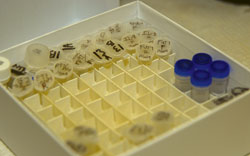
Shown above are reagents used in a ChIP-chip experiment
including vials of transcription factors and various
protein coding genes from HIV-1 genome.
Jessica McConnell
|
With the support of the National Institutes of Health and
the CDC, Children’s National Medical Center currently
is participating in two major research programs. The Pediatric
AIDS Clinical Trials Group led by Hans Spiegel, assistant
professor of pediatrics, microbiology and tropical medicine,
involves 26 sites in the United States and abroad and evaluates
pharmacokinetics, short-term safety, tolerability, and antiviral
activity of HIV medication in patients 6 to 17 years old.
D’Angelo leads the Adolescent Trials Network with 15
sites examining the care, prevention, and treatment aspects
of HIV in adolescents. The long-term goal of the program is
to develop viable community-based HIV prevention interventions.
Additionally, D’Angelo explores ways to limit secondary
transmission in HIV-infected adolescents. Identifying HIV-infected
adolescents presents its own set of challenges, as many of
these individuals are not aware of their HIV status. Children’s
National Medical Center has taken a lead role as a community
resource, offering counseling and testing services to adolescents
and young adults.
Forum Facilitates HIV Research Debate
The Forum for Collaborative HIV Research is an independent
public-private partnership established in 1997 to facilitate
discussion on emerging issues in HIV research. Housed in GW’s
School of Public Health and Health Services’ Department
of Prevention and Community Health, the forum brings together
experts from government, industry, academia, the patient community,
and foundations to address HIV prevention, treatment strategy,
health services, and policy.
Forum Executive Director Veronica Miller says the membership
profile ensures independence and neutrality, and is the key
to the forum’s uniqueness. “The forum identifies
barriers that keep the field of HIV research from moving forward
faster. At the same time, it builds communication and collaboration
between these various groups.”
The forum has benefited from the participation of a wide
range of GW researchers, including Zea; Greenberg; John Palen,
School of Public Health and Health Policy associate dean and
associate professor of health services; and Jeffrey Levi,
associate research professor of health policy.
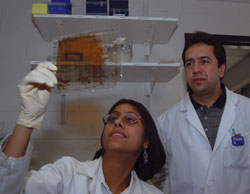
Graduate student Mala Ghai and Professor Fatah Kashanchi
view the result of an experiment that looks at the proteome
of an infected cell using 2-Dimensional gel electrophoresis
before a Mass Spec Proteomics analysis.
|

|
Zea participated in a forum workshop that examined racial
and ethnic minority issues in the management of HIV care,
prevention, and research. She explored whether Latino gay
men disclose that they are HIV-positive to their social network.
Greenberg participated in a workshop to study biomedical
interventions to HIV infection. Instead of the traditional
approach to educating people about how their sexual behavior
can lead to HIV infection, this workshop investigated methods
such as using topical compounds called microbicides to protect
against sexually transmitted infections, providing antiretroviral
treatments to people at high risk to HIV exposure, circumcising
men, and treating herpes simplex virus type 2 (HSV2) since
HSV2-positive men showed a consistent two-fold increase in
the risk of HIV acquisition.
Additional forum projects range from assessing the current
state of HIV therapeutic vaccine development and potential
barriers for moving vaccines forward, especially through the
regulatory process, to designing clinical trials of treatments
and interventions for lipodystrophy—body fat redistribution
that causes side effects that may threaten the long-term success
of antiretroviral therapy.
Systems Approach to Studying HIV/AIDS
Fatah Kashanchi’s research explores the entire HIV
infection system, including the virus, the cells it infects,
and the methods involved in the infection and replication
processes. Through the use of bioinformatics—the collection,
classification, storage, and analysis of biological information
using computers—Kashanchi, professor of biochemistry
and molecular biology, deciphered the complex code of HIV-1,
the virus that causes AIDS. Kashanchi’s research continues
to rely on bioinformatics to study HIV using two technologies:
genomics and proteomics.
“I want to know how certain proteins and pathways
involved in HIV infection talk to each other,” Kashanchi
says. “The only way to study this is to use the systems
biology approach of both proteomics and genomics.”
To study the genomics of HIV-infected cells, or all of the
nucleotide sequences in the chromosomes, Kashanchi routinely
searches through tens of thousands of gene arrays for alterations
in pathways, including transcription, translation, and cell
death. Using this information as well as various bioinformatics
tools, he recently designed inhibitor drugs that seek and
destroy HIV-infected cells.

|
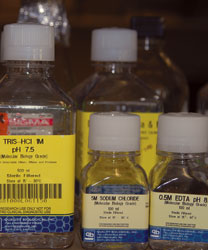
Reagents used to perform molecular biology experiments
related to HIV-1 genomics and proteomics research.
Jessica McConnell
|
To study the proteomics of HIV-infected cells—the structure,
function, and interactions of the proteins produced by the
genes—Kashanchi inspects amino acid chains for changes
to viral proteins following infection with HIV. This approach
could ultimately lead to an AIDS vaccine.
“Genomics and proteomics allow us to study the effects
of specific inhibitors and peptides that could be used as
drugs against HIV,” Kashanchi says.
To learn how the human immune system responds to HIV, Kashanchi
recently developed the first small animal model for HIV/AIDS
that utilizes human stem cells to repopulate the animal with
human immune cells. With this model, he will trace the steps
of an HIV virus as it enters and infects an immune cell. With
this route mapped out, Kashanchi can test different peptides
and drugs to see if they inhibit entry of HIV into an immune
cell.
HIV Infection and Increased Risk of Heart Attack
HIV infection is often associated with an increased risk
of developing atherosclerosis—a build up of fatty deposits
in the vessels feeding the heart. Deposits slowly narrow the
coronary arteries, and complete blockage leads to heart attacks.
Researchers previously attributed these increased risks in
HIV patients to antiretroviral therapy. However, new research
conducted by Michael Bukrinsky, professor and vice chair of
the Department of Microbiology and Tropical Medicine, and
graduate students Zahedi Mujawar and Matthew Morrow shows
that this increased risk may be due to HIV infection itself,
a side effect of HIV’s strategy to increase its infectivity.
“HIV prevents infected cells from releasing cholesterol
into the plasma,” Bukrinsky says. “This makes
the virus happy, because it needs cholesterol to make new
virus particles capable of infecting other cells.”
Bukrinsky currently is investigating what happens when HIV-infected
cells are treated with drugs that stimulate cholesterol release
from cells. “The cells still make the virus, but the
virus is practically noninfectious, because it cannot get
necessary cholesterol,” he says.
In another avenue of research, Bukrinsky examines small molecule
compounds called oxadiazols that inhibit HIV. These novel
antiviral agents come at the perfect time—when incidences
of drug toxicity and resistance are increasing during long-term
treatment of HIV-infected patients. Because HIV can replicate
in non-dividing cells, blocking cell division is not enough
to stop HIV infectivity. Instead, HIV must be blocked from
entering the cell nucleus. The oxadiazols Bukrinsky discovered
inhibit viral DNA from entering the nucleus and can be used
in addition to the HIV cocktail, a three-drug combination
regimen, to boost its effectiveness.
“We participated in the design and testing of these
compounds,” Bukrinsky says. “Currently, studies
are focusing on the pharmacokinetics of these compounds to
improve their delivery. We hope that clinical trials will
be initiated soon.”
For more information about the GW HIV/AIDS Institute,
visit www.gwumc.edu/sphhs/institutescenters/gwuhivaids.
Abby Vogel is a research writer in the Medical Center
Communications and Marketing Office.
Linda Dent, Sarah Freeman, Debbie Goldstein, and Thomas
Kohout contributed to this article.
|